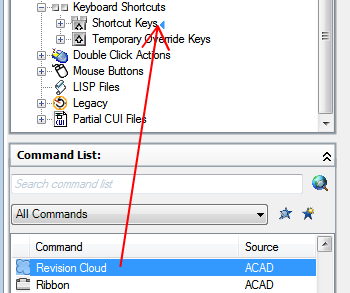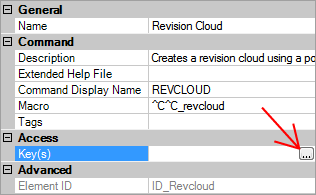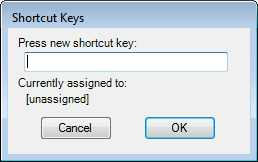- Click Tools
tab
 Customization
panel
Customization
panel  User
Interface.
User
Interface.  At the command prompt,
enter cui.
At the command prompt,
enter cui. - In the Customize User Interface Editor, Customize tab, click the plus sign (+) next to Keyboard Shortcuts to expand it.
- Click the plus sign (+) next to Shortcut Keys to expand it.
- In
the Command List pane, drag the command to the Shortcut Keys node of
the Customizations In <file name> pane.

In the Properties pane, the properties for the new shortcut key you created are displayed.
- In
the Key(s) box, click the […]
button to open the Shortcut Keys dialog box.

- In
the Shortcut Keys dialog box, click in the Press New Shortcut Key
box to ensure the box has focus.

- Hold
down the modifier key CTRL with a combination of SHIFT and ALT if
desired and press a letter, number, function, or virtual key. Valid
modifier and key combinations include the following:
- Function (Fn) keys containing no modifiers
- Number Pad (NUMPADn) keys containing no modifiers
- CTRL+letter, CTRL+number, CTRL+function, CTRL+virtual key
- CTRL+ALT+letter, CTRL+ALT+number, CTRL+ALT+function, CTRL+ALT+virtual key
- CTRL+SHIFT+letter, CTRL+SHIFT+number, CTRL+SHIFT+function, CTRL+SHIFT+virtual key
- CTRL+SHIFT+ALT+letter,
CTRL+SHIFT+ALT+number, CTRL+SHIFT+ALT+function, CTRL+SHIFT+ALT+virtual
keyNoteThe virtual keys that are supported are Escape, Insert, Delete, Home, End, Page Up, Page Down, Left Arrow, Right Arrow, Up Arrow, and Down Arrow. The virtual key Escape can only be used by itself or with the modifier combination CTRL+SHIFT+ALT.
Under the Press New Shortcut Key box, Currently Assigned To displays any current assignments for the shortcut key.
- If you do not want to replace the current assignment, use a different shortcut key. Otherwise, click OK to assign the shortcut key and close the Shortcut Keys dialog.
- In the Customize User Interface Editor, click OK.






